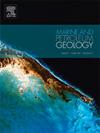埃及尼罗河三角洲盆地侏罗系-白垩系古环境与烃源岩潜力:来自孢粉学和有机地球化学的见解
IF 3.7
2区 地球科学
Q1 GEOSCIENCES, MULTIDISCIPLINARY
引用次数: 0
摘要
尽管在尼罗河三角洲(尤其是地中海近海)进行了数十年的积极勘探,但由于钻探岩心数量有限,中生代地层的沉积背景和烃源岩潜力仍不清楚。通过其综合方法,本研究旨在填补我们对埃及和地中海地区最大的含油气盆地之一的侏罗纪-白垩纪古环境和烃源岩潜力的认识空白。研究的层序来自尼罗河三角洲盆地的Abu Hammad-1井,这是该盆地唯一一口穿透侏罗纪-白垩纪的井。我们的研究提出了一种综合的孢粉学和有机地球化学方法,为获得精确的见解和将年龄与沉积环境、干酪根类型和热成熟度联系起来提供了全面可靠的方法。孢粉学数据补充了有机地球化学分析,包括总有机碳、岩石热解、生物标志物和元素数据。获得的孢粉学结果显示了两个不同的组合,从年轻到古老,分别为Barremian-Aptian和bathonian - kimmeridian。所研究的沉积物来源于稳定、富氧、缺氧底水的近岸海洋环境。这种特殊的环境和靠近海岸线的环境使有机物质的保存程度降到最低。有机质含量以ⅲ型和ⅳ型干酪根为主,有机质来源为陆生植物和无定形有机质。烃源岩表征为低热成熟度。该研究为研究尼罗河三角洲盆地上侏罗统和下白垩统地质提供了有价值的信息,有助于预测沉积环境和烃源岩。本文章由计算机程序翻译,如有差异,请以英文原文为准。
Paleoenvironment and source rock potential within the Jurassic-Cretaceous succession of the Nile Delta Basin, Egypt: Insights from palynology and organic geochemistry
Despite decades of active exploration in the Nile Delta, particularly in the offshore Mediterranean, the depositional settings and source rock potential of the Mesozoic strata remain unclear, primarily due to the limited number of drill cores. With its comprehensive approach, this study aims to fill gaps in our understanding of the Jurassic-Cretaceous paleoenvironments and source rock potential in one of the largest petroleum basins in Egypt and the Mediterranean region. The investigated successions are from the Abu Hammad-1 well in the onshore Nile Delta Basin, the only well that penetrated the Jurassic-Cretaceous in the basin. Our study presents an integrated palynological and organic geochemical approach, offering a comprehensive and reliable method for gaining precise insights and linking age dating to depositional environments, kerogen types, and thermal maturity. Palynological data are supplemented with organic geochemical analyses, comprising total organic carbon, Rock-Eval pyrolysis, biomarker, and elemental data. The obtained palynological results reveal two distinct assemblages, from younger to older, dated as Barremian-Aptian and Bathonian-Kimmeridgian, respectively. The studied sediments are derived from nearshore marine environments characterized by stable, oxygen-rich, suboxic bottom waters. This specific setting and proximity to the shoreline contribute to minimal preservation of organic matter. The organic content is dominated by Type III and Type IV kerogen, indicating a gas-prone source derived from terrestrial plant material and amorphous organic matter. Source rock characterization shows low thermal maturity. The study provides valuable insights into the Upper Jurassic and Lower Cretaceous geology of the Nile Delta Basin, facilitating the prediction of depositional environments and source rocks.
求助全文
通过发布文献求助,成功后即可免费获取论文全文。
去求助
来源期刊

Marine and Petroleum Geology
地学-地球科学综合
CiteScore
8.80
自引率
14.30%
发文量
475
审稿时长
63 days
期刊介绍:
Marine and Petroleum Geology is the pre-eminent international forum for the exchange of multidisciplinary concepts, interpretations and techniques for all concerned with marine and petroleum geology in industry, government and academia. Rapid bimonthly publication allows early communications of papers or short communications to the geoscience community.
Marine and Petroleum Geology is essential reading for geologists, geophysicists and explorationists in industry, government and academia working in the following areas: marine geology; basin analysis and evaluation; organic geochemistry; reserve/resource estimation; seismic stratigraphy; thermal models of basic evolution; sedimentary geology; continental margins; geophysical interpretation; structural geology/tectonics; formation evaluation techniques; well logging.
 求助内容:
求助内容: 应助结果提醒方式:
应助结果提醒方式:


